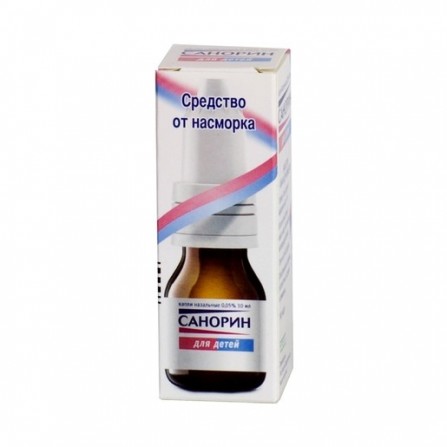Sanorin nasal drops of 0.05% 10 ml
Condition: New product
999 Items
Rating:
Be the first to write a review!

More info
Active ingredients
Naphazoline
Release form
Drops
Composition
Active ingredient: naphazoline nitrate. Excipients: ethylenediamine; boric acid; methyl parahydroxybenzoate; water
Pharmacological effect
Vasoconstrictor, anti-congestive
Pharmacokinetics
When applied topically, naphazoline is completely absorbed.
Indications
Acute rhinitis; sinusitis; Eustachitis; laryngitis; to facilitate rhinoscopy; the need to stop nosebleeds; as an additional agent in the treatment of conjunctivitis of bacterial origin (for nasal drops of 0.05%).
Contraindications
Hypersensitivity to the drug; chronic rhinitis; atrophic rhinitis; angle-closure glaucoma; severe eye disease; arterial hypertension; pronounced atherosclerosis; tachycardia; hyperthyroidism; diabetes; simultaneous administration of monoamine oxidase inhibitors and a period of up to 14 days after the end of their use. Sanorin 0.05% solution is contraindicated in children under 2 years.
Use during pregnancy and lactation
Data on the safety of the drug during pregnancy and lactation (breastfeeding) is not provided
Dosage and administration
Intranasal. Children from 2 to 15 years old: 1–2 drops of a 0.05% solution of Sanorin in each nasal passage 2–3 times a day with an interval of at least 4 hours. Apply briefly, not more than 1 week. in adults and not more than 3 days in children. If nasal breathing is facilitated, then the use of the drug Sanorin can be finished earlier. Reapplication is possible in a few days. In the case of nasal bleeding, a cotton swab moistened with a 0.05% solution of the drug can be placed in the nasal passage. Drug Sanorin drops buried in every nasal passage with a little head thrown back. When instilled into the left nasal passage, you should tilt your head to the right, and when instilled into the right nasal passage - to the left.
Side effects
On the part of the digestive system: nausea. Since the cardiovascular system: tachycardia, increased blood pressure. From the side of the central nervous system: headache, irritability. Allergic reactions: rash. Local reactions: reactive hyperemia, swelling of the mucous membrane of the nasal cavity; when applied for more than 1 week - irritation, in some cases - swelling of the nasal mucosa
Overdose
Symptoms: prolonged or frequent administration of the drug Sanorin into the nasal cavity may cause swelling of the nasal mucosa and a feeling of congestion.The danger of overdose (especially if swallowed) of the drug Sanorin occurs in young children and can cause CNS depression, manifestations of which are drowsiness, lower body temperature, increased sweating, slower heart rate, increased blood pressure or its subsequent decrease, extremely rare - coma. Treatment: drug withdrawal, symptomatic therapy
Interaction with other drugs
With simultaneous use of the drug with monoamine oxidase inhibitors or tricyclic antidepressants (up to 14 days after their use), blood pressure may increase, which is due to the release of deposited catecholamines under the action of naphazoline. Therefore, the simultaneous administration of the drug Sanorin with MAO inhibitors (and within 14 days after their cancellation) is contraindicated. Naphazoline slows down the absorption of local anesthetics (lengthens their action)
special instructions
With prolonged use, the severity of the vasoconstrictive action gradually decreases (the phenomenon of tachyphylaxis), and therefore it is recommended to take a break for several days after 5-7 days of use in adults and after 3 days of use in children. The drug may have a resorptive effect. The need for the use of the drug Sanorin with other drugs, the doctor determines individually


